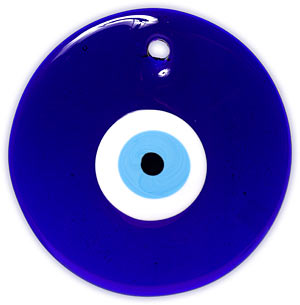Evil eye

Evil eye
The evil eye is a look that is superstitiously believed by many cultures to be able to cause injury or bad luck for the person at whom it is directed for reasons of envy or dislike. The term also refers to the power attributed to certain persons of inflicting injury or bad luck by such an envious or ill-wishing look.
Mediterranean cultures and many others around the world believe in the concept of the “evil eye.” Symptoms may include diarrhea, constant crying, and, in some cases, even death. It usually affects infants and children, however, adults can also be affected.
The idea expressed by the term causes many cultures to pursue protective measures against it. The concept and its significance vary widely among different cultures. The idea appears several times in translations of the Old Testament. It was a widely extended belief between many Mediterranean tribes and cultures: Classical Greece probably learned this belief from ancient Egypt, and later passed it to ancient Rome.
Forms of belief
In some forms, it is the belief that some people can bestow a curse on victims by the malevolent gaze of their magical eye. The most common form, however, attributes the cause to envy, with the envious person casting the evil eye doing so unintentionally. Also the effects on victims vary. Some cultures report afflictions with bad luck; others believe the evil eye may cause disease, wasting, or even death. In most cultures, the primary victims are thought to be babies and young children, because they are so often praised and commented upon by strangers or by childless women.
In many beliefs, a person—otherwise not malefic in any way—can harm adults, children, livestock or possessions, simply by looking at them with envy. The word “evil” is somewhat misleading in this context, because it suggests an intentional “curse” on the victim. A better understanding of the term “evil eye” can be gained from the old English word for casting the evil eye, namely “overlooking”, implying that the gaze has remained focused on the coveted object, person, or animal for too long.
While some cultures hold that the evil eye is an involuntary jinx cast unintentionally by people unlucky enough to be cursed with the power to bestow it by their gaze, others hold that, while perhaps not strictly voluntary, the power is called forth by the sin of envy.
History
The amount of literary and archeological evidence attests to the belief in the evil eye in the eastern Mediterranean for millennia starting with Hesiod, Callimachus, Plato, Diodorus Siculus, Theocritus, Plutarch, Heliodorus, Pliny the Elder, and Aulus Gellius. Studying these written sources in order to write on the evil eye only gives a fragmented view of the subject whether it presents a folkloric, theological, classical, or anthropological approach to the evil eye. While these different approaches tend to reference similar sources each presents a different yet similar usage of the evil eye, that the fear of the evil eye is based on the belief that certain people have eyes whose glance has the power to injure or even kill and that it can be intentional or unintentional.
Protective talismans
The blue eye, known as μάτι (mati), “eye,” as an apotropaic visual device, is known to have been a fixture in Greece dating back to at least the 6th century BC, when it commonly appeared on drinking vessels. In Greece, the evil eye is cast away through the process of xematiasma (ξεμάτιασμα), whereby the “healer” silently recites a secret prayer passed over from an older relative of the opposite sex, usually a grandparent. Such prayers are revealed only under specific circumstances, for according to superstition those who reveal them indiscriminately lose their ability to cast off the evil eye. According to custom, if one is indeed afflicted with the evil eye, both victim and “healer” then start yawning profusely. The “healer” then performs the sign of the cross three times, and spits in the air three times.


